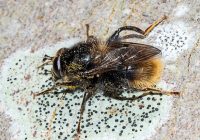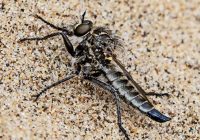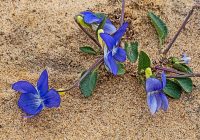Dr Phil Smith’s Wildlife Notes
April 2022
Following on from an exceptionally dry March, the spring drought continued with only five days of measureable rainfall in April and none after 12th. By the end of the month even the TV weather presenters were acknowledging that “gardeners would appreciate some rain.” You might well ask why farmers, growers, the water supply industry and the natural environment did not merit similar concerns! The Met. Office acknowledged “a run of dry Aprils in recent years.” In fact, this weather pattern extends back to 2000, as I have repeatedly pointed out in these notes. Cold dry nights meant awful breeding conditions for Natterjack Toads. I heard one call briefly at Hightown on 27th and that was it. At least, some sun-loving insects benefited. I was keen to catch up again with the almost mythical Early Bear Hoverfly that I saw in March. On 8th I was crossing Falkland’s Way dunes on my way to Ainsdale NNR when I spotted a familiar shape on a sunny Sycamore trunk. It was an Early Bear Hoverfly, doing its bumblebee impression. It even tolerated a close approach for photos. Many more spring-flying hoverflies appeared during the month, especially on south-facing woodland edges where they love to bask on young Sycamore leaves. At Ravenmeols, I recorded 14 species, including one that was new to me – the Triangle-spotted Syrph, a tiny black hoverfly with triangular yellow markings. Overall, however, numbers of hoverflies were much reduced by the dry conditions.
Another insect highlight of the month was a Sefton Coast speciality, the Spring Heath Robberfly, the smallest of its family. From the 9th onwards I recorded no less than 44 of these fierce little predators, most on sandy paths, while others were on sunny logs or fences. The robberfly is superficially similar to St Mark’s-fly that is so abundant in the dunes at this time of year, so care is needed not to confuse the two. I photographed what I thought was a Spring Heath Robberfly at Ainsdale LNR, only to discover later that it was the much commoner Fan-bristled Robberfly. Another easily overlooked denizen of sandy tracks through the dunes is the Coastal Silver Stiletto fly, a stunning little beauty that is covered in silver hairs. In a short walk across the Hightown dunes, I counted 12 of them. Early April is also the time for the Early Colletes or Vernal Mining Bee as it used to be called. This Red-listed solitary bee was especially numerous this year, creating nesting burrows on south-facing fixed-dune slopes and foraging for nectar and pollen on Creeping Willow catkins. One of my regular visits to the Devil’s Hole coincided with a particularly cold day so that I could get close-up photos of an insect that is usually non-stop. At Hightown dunes, I was pleased to see that bare patches created by Gems in the Dunes volunteers a few years ago have been colonised by nesting Early Colletes bees. I was also on the lookout for the much larger cuckoo bumblebee, as I needed its photo for a book I am writing on Insects of the Sefton Coast. The following day, I found one at Freshfield, a Vestal Cuckoo-bee on a dandelion flower. This is the commonest and largest of a group that mimics bumblebees and takes over their nests, so that the cuckoo offspring are raised by the workers of their host. The cuckoos even have an almost silent flight, presumably to help with the takeover.
As usual, the month was enlivened by early butterflies. A male Orange Tip always lifts the spirits. My first for the spring was at Ravenmeols on 16th, joined by Speckled Woods in the dappled sunlight of woodland glades. Peacocks were emerging from hibernation and there seemed to be more Holly Blues than usual. I even spotted a male Brimstone, a rarity on the coast, heading north at a rate of knots. The same day, I counted 15 Northern Dune Tiger Beetles, a nationally rare ‘flagship’ species, at the Devil’s Hole blowout.
During my walks in the dunes, I visited several bushes of the extremely rare Don’s Willow. Three possible new recruits were spotted last winter at Ravenmeols, Ainsdale Local Nature Reserve and Birkdale but I needed to see the catkins to confirm the identifications. I had to get my wellies on and wade out into a flooded slack to get to the Birkdale plant. Pleasingly, all three were found to be Don’s Willows, the Ravenmeols bush being a female, while the other two were males with striking red anthers. This brings the total number of bushes of this hybrid in Sefton to 40, only four being known in the rest of Britain. During visits to Ainsdale LNR, I was impressed by the condition of slacks cleared of scrub the winter before last and then cattle-grazed. A great variety of small plants is benefiting from the open disturbed ground, including rarities like Sticky Stork’s-bill and Heath Dog-violet.
Throughout April I was serenaded by the songs of birds returning for the summer. An early Whitethroat was at Hightown on 14th, while Chiffchaffs, Willow Warblers and Blackcaps were everywhere. I even had a calling Ringed-necked Parakeet flying south at Hightown. It was my first on the coast but this invader is now breeding in Crosby and Blundellsands.






